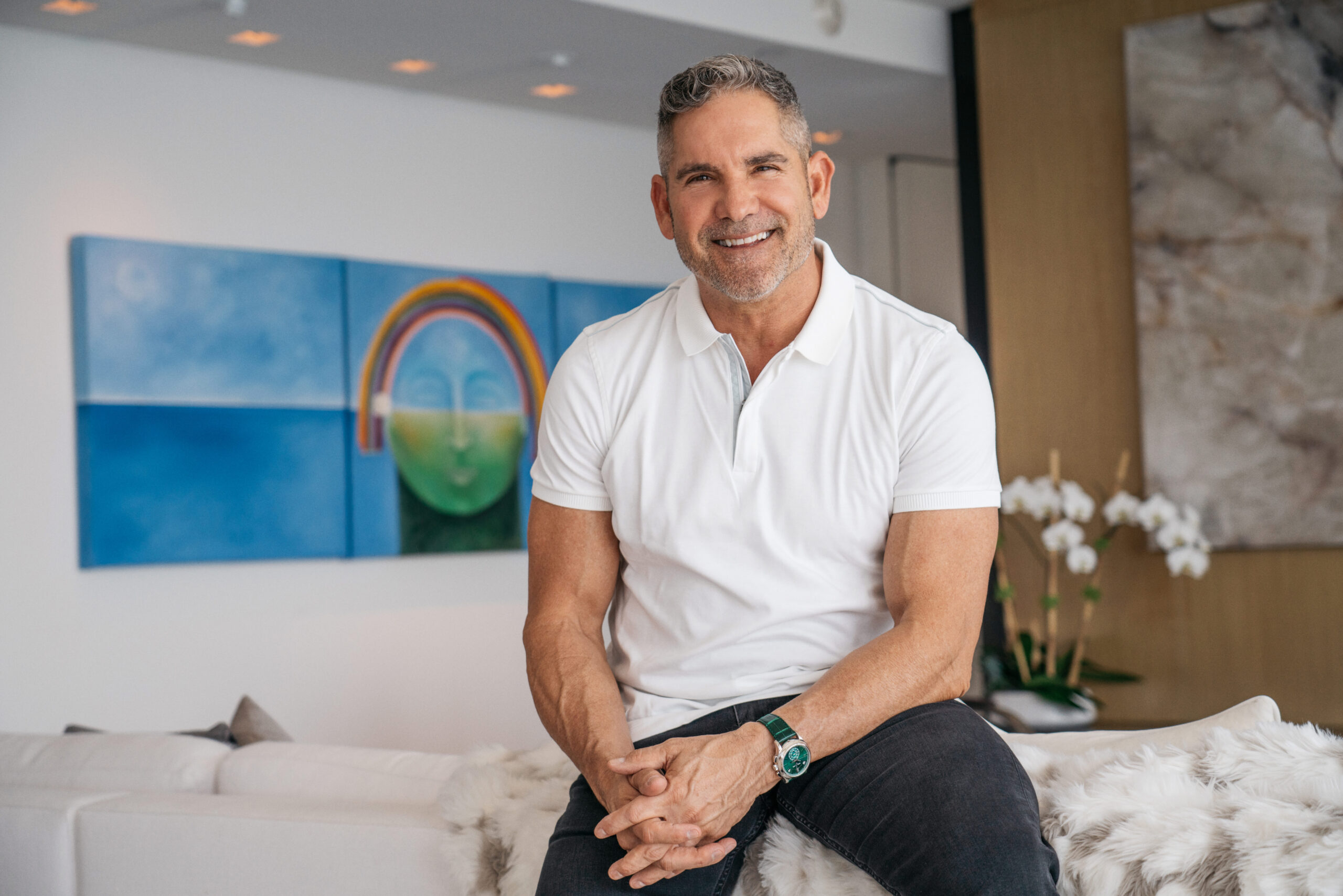- Real estate entrepreneur Grant Cardone, who has a gallery in his Miami home, said collecting art brings him more satisfaction than investing in the stock market.
- Christian Levett, a former investment manager, opens his home in Florence for private tours of his all-female art collection.
- The Boros Collection houses contemporary art in a huge World War II bunker in Berlin, and owners Christian and Karen Boros live in a maisonette above it.
Entrepreneur Grant Cardone said collecting and exhibiting art gives him more satisfaction than investing.
Grant Cardone
Multi-millionaire Grant Cardone, who has been collecting art for about 15 years, says he’s a spontaneous buyer.
“I don’t consider myself a connoisseur. I’m very new to the art world. If I like it, I buy it. I don’t care who made it,” he told CNBC. Along with works on display in his home, Cardone also has an art gallery to house his considerable collection.
CNBC spoke with Cardone via video call — behind him in his Miami home office was an untitled piece by American graffiti artist Retna that Cardone bought at an online auction.
“I clicked the button – I really hadn’t done any research … and I got the piece … And it got here and I absolutely loved it,” he said. He paid “maybe $140,000” for the work, he said.
A work called “The Time Is Now” by artist Fringe, seen at Grant Cardone’s Home Gallery.
Grant Cardone
Along the hallway in Cardone’s home are two works by American pop artist Burton Morris, both depicting red Coca-Cola bottles arranged in a repeating pattern called Coca-Cola 50A and Coca-Cola 50B. “I bought this from Tommy Hilfiger … it reminds me of the importance of scaling,” said Cardone — fashion designer Hilfiger is the previous owner of the home.
Cardone, a real estate investor and author of The 10 X Rule: The Only Difference Between Success and Failure, has about 17 million followers on social media and uses his platforms to occasionally give advice on art investing.
“[Followers are] starting to see art saying hey you know [has] was that good for you? And I’m like, yeah, it’s good for me… It’s better than the dollar or the euro… The stock market doesn’t give me satisfaction, I don’t go back and look at my Apple stock and feel good about it. But I walk into my gallery or my kitchen or my office and I see a piece and I’m like, man, that’s super cool.”
The gallery at Grant Cardone’s Miami home. A print of a work by Basquiat is seen in the lower left.
Grant Cardone
Inside Cardone’s gallery — complete with floor-to-ceiling windows and security — is a work by American contemporary artist Kenny Scharf titled “Blipsibshabshok” (1997), an abstract painting featuring colorful futuristic symbols. Cardone owns a second Scharf, “Controlopuss” (2018), a striking image of a red, many-legged creature, acquiring it for $279,400 from Phillips Auction House.
“This here is Basque. The original will cost $45 million,” Cardone said, pointing to a print of a Jean-Michel Basquiat work titled Flexible (1984/2016). The original was sold by Phillips Auction House for $45.3 million in 2018. “I bought this piece with the house,” he said, pointing to a Basquiat piece titled “Read More” by American contemporary artist Al-Bassier Holley.
Grant said he chooses pieces to buy on instinct. “I’ll try to get away from him. And if I keep seeing it or I keep thinking about it, then I go back and say, OK, I’ve got to have this,” he said.
“I plan to never sell this stuff. They are really for my personal enjoyment. And you know, art makes me happy,” he said.
Former investment banker Christian Levett has a different approach. He has been collecting art for almost 30 years, beginning with Old Master paintings and Roman, Greek and Egyptian antiquities before moving on to works by female Abstract Expressionists.
Art collector Christian Levett gives private tours of his home in Florence, Italy. His collection is largely made up of abstract expressionist works by women artists.
Christian Levett
In addition to owning an art museum in Mougins, France, Levet organizes tours of the artworks on the walls of his home in Florence, Italy, where he lives six months of the year—his entire home could be said to be an art gallery. “It’s kind of like a museum with a private tour,” Levett told CNBC by phone.
Near the city’s famous Ponte Vecchio bridge, Levett’s home has 20-foot ceilings, original frescoes and two floors of artwork, all by women. The collection is largely made up of abstract expressionist works by artists such as impressionist Mary Cassatt and surrealist Dorothea Tanning.
Once or twice a week, Levett invites small groups to see his collection, often giving tours himself. The groups are sometimes composed of students from American colleges that have outposts in Florence, such as Harvard University and New York University, or come from museum or patron groups.
A 1977 painting by American artist Joan Mitchell is a highlight of Levett’s collection, he said. The large work, titled When They Were Gone, is nearly 240cm high and 180cm wide and hangs in his dining room.
Levett acquired it for about $2.8 million around 2015.
Christian Levett has moved from collecting antiques to works by women artists, seen here at his home in Florence.
Christian Levett
“Now there’s probably a $15 million to $18 million painting at auction…Mitchell has always been one of the most important women artists of the 1920sth century,” Levett said.
He also spoke highly of an Elaine de Kooning oil painting of John F. Kennedy, commissioned as part of a series of portraits of the former US president in 1963. Levett bought the work in 2020, paying about $600,000 .
Levett said she opens her home to students in part because it might spark interest in supporting the arts in the future. “Students … are the acorns of the art world,” he said.
The work of female artists is Levet’s focus, and he is set to reopen his museum in France as the Female Artists Mougin Museum on June 21. He is currently selling the museum’s former collection of art and antiquities through a series of auction sales at London’s Christie’s, which have fetched almost £9.5 million ($11.9 million) so far.
Christian and Karen Boros’ home sits atop the bunker that houses their private art collection, the Boros Collection, in downtown Berlin, Germany.
John McDougall | AFP | Getty Images
In a unique art space in Berlin, husband and wife Christian and Karen Boros live in a 6,000-square-foot maisonette above their personal collection. The Boros collection is housed in a former World War II bunker, a huge, tall building that the couple acquired in 2003 and spent several years turning it into a five-story exhibition space, with their home on the sixth.
The bunker housed up to 4,000 people during the war, then was used as a tropical fruit warehouse before being converted into a nightclub. According to Raoul Zoellner, director of the Boros Foundation, 450 tons of concrete ceilings and walls were removed during its conversion into an exhibition space and home.
Artwork by Cyprien titled ‘Gaillard Lesser Koa Moorhen’, 2013, part of the Boros Collection.
Boros Collection, Berlin | Noshe
Christian, an advertising entrepreneur, bought his first piece of art – a spade by German artist Joseph Beuys – when he was 18, he told the Financial Times.
“The bunker is not a museum … but an extraordinary project initiated by an enthusiastic pair of collectors who could not have imagined how many diamond saws it would take to knock down dozens of bunker walls – or what would drive it,” Zoellner said in statement by email.
Karen and Christian Boros live in a maisonette above their art collection in Berlin.
Max von Gumpenberg
Nearly 600,000 people have taken guided tours of the bunker since its conversion in 2008, with pieces from the Boros collection on display on rotation, Zoellner added. There are currently 114 works on display with a “focus on the human body in multiple positions,” Zoellner said. “The work is based on the constant compulsion to optimize, the gradual adaptation of our bodies to technological devices,” he said.



